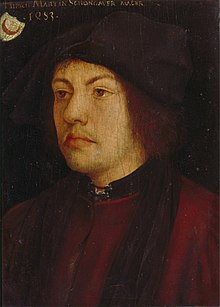
Martin Schongauer (c. 1450–53, Colmar – 2 February 1491, Breisach), also known as Martin Schön ("Martin beautiful") or Hübsch Martin ("pretty Martin") by his contemporaries,[2][3] was an Alsatian engraver and painter. He was the most important printmaker north of the Alps before Albrecht Dürer, a younger artist who collected his work. Schongauer is the first German painter to be a significant engraver, although he seems to have had the family background and training in goldsmithing which was usual for early engravers.[4]
The bulk of Schongauer's surviving production is 116 engravings,[5] all with his monogram but none dated,[6] which were well known not only in Germany, but also in Italy and even made their way to England and Spain.[7] Vasari says that Michelangelo copied one of his engravings, in the Trial of Saint Anthony. His style shows no trace of Italian influence, but a very clear and organised Gothic, which draws from both German and Early Netherlandish painting.
Recent scholarship, building on the work of Max Lehrs, attributes 116 engravings to him, with many also being copied by other artists (including his monogram), as was common in the period. His prolific contemporary Israhel van Meckenem did close copies of 58 engravings, exactly half of Schongauer's output, and took motifs or figures from more, as well as apparently engraving some drawings that are now lost.[8]
There are some fine drawings, including ones dated and signed with his monogram, and a surviving few paintings in oil and fresco.
- ^ This painting, in Munich, appears to be a 16th-century copy, possibly by Hans Burgkmair, of a lost original painting or drawing, presumably of 1483 (the date on the painting), perhaps by Thoman Burgkmair. See Hutchison, 6 note 2; Shestack, 87
- ^ "Der hübsche Martin... Martin Schongauer". smb.museum. Retrieved 2 January 2017.
- ^ "Martin Schongauer German engraver". britannica.com. Retrieved 2 January 2017.
- ^ Shestack, biography
- ^ Max Lehrs' count, followed by Shestack and Hutchison, though there is now doubt over one – see Bartrum, 20
- ^ Shestack, biography, #34
- ^ Ducay for Spain
- ^ Shestack, 119–205, 183–194